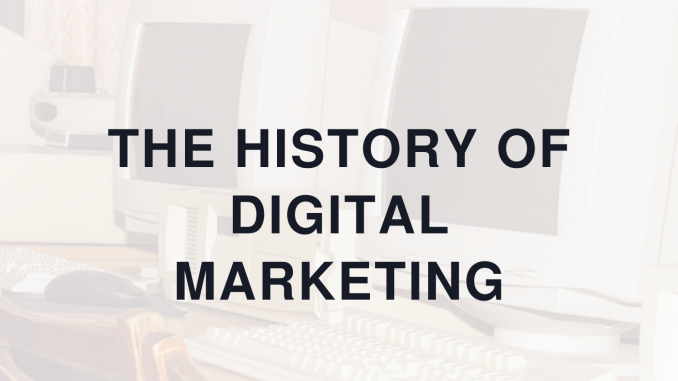
In most fields of study, there is historical knowledge of what came before. We know who invented the light bulb (thanks, Thomas Edison) and we know who invented the telephone and what he said on that first call (Alexander Graham Bell called his assistant and said “Mr. Watson, come here. I want to see you.”). But for those of us who are digital marketing practitioners, there is very little known or understood about the origins of digital marketing. Since most of us learn how to “do SEO” or build a PPC campaign through on-the-job training, we don’t have a strong historical basis or understanding that you’d typically learn in school. As a result, I wanted to put together a timeline with some historical background for digital marketing to develop a framework from which to observe the changes we’ve seen in only 30 years. We learn much about who we are from history; we grow and adapt based on historical experiences, so let’s dig into the history of digital marketing.
1991 – Tim Berners-Lee and his team launched the World Wide Web project. I am starting here, even though there is much debate on “who invented the internet” and how it all began. The first email was sent in 1971, after all, and so there’s some debate on the origins of the internet. However, Tim Berners-Lee is known for having invented the World Wide Web, an “Internet-based hypermedia initiative for global information sharing” while at CERN in Switzerland. He wrote the first web client and server in 1990 and his specifications of URLs, HTTP, and HTML were refined as Web technology spread, so his contributions to our understanding of websites as we know them today are incredibly important.
1994 – Netscape, Yahoo!, and Amazon launch. AOL and eBay followed soon after in 1995. Search engines are now starting to change how we access and understand information and how we research and purchase products. At its inception, getting your website to rank in the search engines was easy and relatively straightforward. There was little competition on the web, so things like keyword stuffing, excessing tagging, buying links, and putting white text on a white background were reasonably common strategies that are now black-hat SEO. But the pivot from finding information in an encyclopedia (looking at you, Encarta!) to being able to find it indexed on the web changed our consumption pattern of information and started to change how we shop.
1998 – Google is founded. Now the behemoth of search that we all know, it didn’t launch with as much fanfare. Their claim to fame and value prop at the time, however, was the simplicity of their interface – just a little box in the center for searching. Founded by Larry Page and Sergey Brin, their goal was to “organize the world’s information and make it universally accessible and useful.”
2000 – Web 2.0 is introduced. The dot-com bubble had burst by this point and the world of digital has indicated that we have to build websites that are not only delivering content, but are also interactive. User-generated content, storing data in the cloud, and the first precursors to social media are changing how we view, access, and use the content on the internet.
2003 – Myspace was founded, Facebook followed in 2004, and in 2007 Twitter was created. Social media has now officially arrived. Now used by more than two-thirds of internet users, social media is the “location, location, location” for most businesses. Connectivity between people across distances is easier than ever, communication is faster, and both individuals and businesses are more visible than ever.
2006 – Oxford Dictionary adds “Google” as a verb. Our lexicon is changing. Our understanding of the internet and its presence in our lives is changing. The internet and digital marketplace are no longer a small part of people’s lives, they are an over-arching and inextricable component of our lives.
2007 – The iPhone is released. Remember your parents telling you to do your homework and learn your math because you wouldn’t have a calculator in your pocket all the time? Well, now we do. And a camera, a web browser, and access to our email and our music. Sure, the earliest iPhones were pale shadows of what we can now do with an iPhone, but the introduction of the iPhone signaled the beginning of mobile dominance in how we access the internet. It was now in the palm of our hands, always there, always ready.
2011 – US adults spend an average of 46 minutes a day on their phones, but by 2017 that number was already 258 minutes – 5.5 times the amount from just six years prior. Greater numbers of people have access to digital devices, the internet, smartphones, and eCommerce.
2020 – The Pandemic hits. How does it impact digital marketing and the internet? Websites are pushed to become more responsive, offer more mechanisms for online ordering, facilitate real-time sharing of information, and allow us access to things we could no longer do in person. Zoom meetings and classes, virtual events, and delivery make sure that even something as mundane as grocery shopping can now be done completely online.
So what’s next? Where do we go from here? From personal assistants (Hey, Alexa!) to the internet of things (watches and smart houses) to the repercussions of the COVID-19 pandemic that remain to be seen, digital marketing remains a wild-west frontier and it’s hard to imagine what will happen in our increasingly interconnected world. What do you think will happen next?
If you need help with your digital marketing and bringing your marketing into the 21st century and beyond, contact us for a quote and we’ll be happy to help!

Leave a Reply